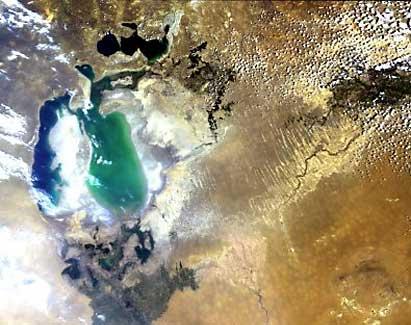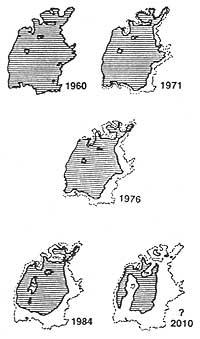Sea Aral to extinguish
2003/09/07 Andonegi Beristain, Garazi - Elhuyar Zientziaren Komunikazioa
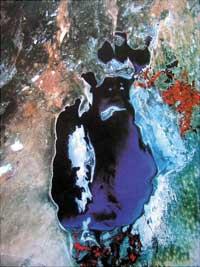
The Aral Sea is in Asia, between Uzbekistan and Kazakhstan. The name Aral means island and, unfortunately, today, Aral Itsaso looks like an island in the middle of the desert. Since 1960, water level has dropped 13 meters and lost three quarters of the total water it had at first. Its surface has dropped by half and has exposed 40,000 square kilometers of salt land, the youngest desert on Earth. The new desert already has its name: Aralar
The Aral Sea has changed a lot in appearance. The ancient great lake has been divided into two: the main lake has remained to the south and there is a small deeper lagoon to the north. It seems that the small northern lagoon has no immediate danger of disappearing, but in the south things are very different. The depth of southern lake waters is not high, so researchers believe it will evaporate by 2020. Is there no salvation for the Aral Sea?
Thirst for cotton and rice
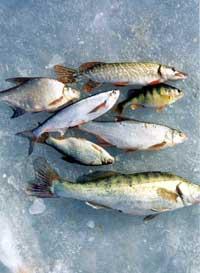
The Aral Sea was watered by two rivers, Amu Darya and Syr Darya. The Amu Darya River, known since the time of Alexander the Great, was the largest river in Central Asia, wider than the Nile. Its waters watered in the south, but now they give it not a drop.
Since the 1960s, the waters of Amu Darya began to be used for irrigation of cotton and rice plantations in the region. Consequently, the decline of the river itself and the Aral Sea began. By the 1980s, Amu Darya barely gave water to the Aral Sea.
This river was the main flow of the Aral Sea and, after its interruption, the saline concentration of the lagoon increased enormously. Currently, the saline concentration of the lagoon is three times higher than that existing in open sea, which has led to the disappearance of more than 20 species of fish that inhabited the lagoon.
Influence of the Aralkum desert
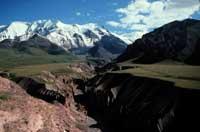
Habitats that protected wildlife have disappeared and the decline of the lagoon has significantly influenced the climate, producing colder and hotter winters in summer. In addition, in the desert of Aralkum strong storms of sand and salt are generated every year that move 150,000 tons of salt and sand. These storms carry the desert chaparron for several kilometers. In fact, it is believed that they influence the droughts of distant forage pastures and the melting of the glaciers of the Pamir Mountains, on the border of Afghanistan.
According to scientists, these sandstorms also negatively affect the health of the inhabitants of the region. In fact, storms join pesticide residues along the way and spread harmful substances into miles of health. This phenomenon has been related to respiratory diseases of the population and some types of cancer.
Population, main victims
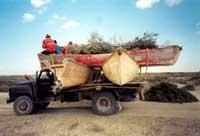
Undoubtedly, its inhabitants have been one of the first to suffer the consequences of the drought. Muyna's case has been a clear example. Muyna is a fishing village located on the shores of the Aral Sea. Now, the village is 150 km from the seashore and almost 2,000 fishermen working there have lost their jobs. Those who considered a form of fishing life had to abandon their work twenty years ago and those who continue fishing have to take cars and go out every day in search of the coast.
If the loss of livelihoods were not enough, diseases have also increased, including tuberculosis. Between 2001 and 2002 cases of tuberculosis in Muyna have grown by 70%. They do not have fresh food or clean water, the climate has hardened and therefore grow weaker in the face of diseases.
Save the smallest
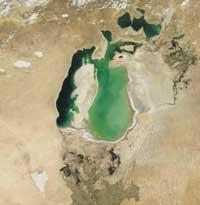
Despite the seriousness of the situation, scientists consider it impossible to save the entire Aral Sea. Although it was intended to divert the rivers from Siberia to it, this will not be possible. On the other hand, the local economy is very dependent on cotton and considers that land irrigation cannot stop completely.
At the moment, they have decided that the most viable option is to save the small lagoon in the north of the Aral Sea. To protect it, a series of barriers and walls have been built so that the water does not pass to the large lagoon and the saline concentration of the water is maintained in due conditions. However, the results have not been good.
Scientists believe that the water path that joins the two lagoons will quickly dry up spontaneously, and so they think that the small northern Aral will be saved on their own.
Meanwhile, Aralkum begins to investigate the desert basin to study the plants that can grow in it. The plants will contribute to the soil consolidation of the lagoon and prevent sand and salt storms. That, of course, will not be a solution to all problems, but it will help.
Published in 7K.

Gai honi buruzko eduki gehiago
Elhuyarrek garatutako teknologia



